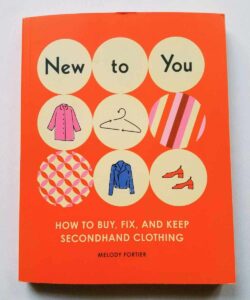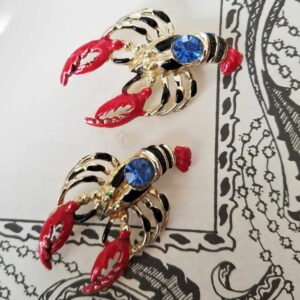This post was last updated on April 2nd, 2023 at 03:18 pm
What I admire most about vintage clothing—being the frugal shopper that I am—is the high quality compared to today’s fast-fashion offerings. Vintage fabric and construction are superior. But I will admit that shopping for vintage clothes can be intimidating because I’m not always sure where to look or what to look for.
So when I recently spotted Melody Fortier’s book, “New to You: How to buy, fix, and keep secondhand clothing,” I had to pick it up. This was my chance to better understand the topic.
I was happy to discover you don’t need a background in fashion to read this book. To be sure, Melody is an expert, as she previously worked in the fashion industry. Her book covers a lot of ground, and one of the most helpful sections discusses how to date clothing. You’ll also learn what kinds of damage can be fixed and, just as important, what cannot. Vintage shopping is part treasure hunt and part detective work.
After reading “New to You,” I felt inspired to take our daughter vintage shopping. The two of us had a blast, and I felt confident as we browsed the racks together. That’s when I decided to ask Melody, who lives in Massachusetts, for an interview. We chatted last month, and she had some great advice for vintage beginners such as myself and our daughter.

Vintage clothing pitfalls to avoid
A potential pitfall when vintage shopping is sizing. As Melody describes it, vintage sizes (at least for women) don’t equal modern sizes. There’s a simple reason for this, she explained.
“The industry discovered if you tell a woman that she’s now wearing a size 8 dress instead of a size 10 dress, she’s going to buy that size 8 dress just to say she’s wearing an 8. Every year, the sizes would change a little bit so women would be in smaller sizes. So you cannot rely on vintage sizing at all,” Melody said.
Some shops, including one that my daughter and I visited, convert the sizes for you. The prices might be a little higher at these shops, but I think it’s worth having someone do this work for you. Regardless of where you shop, I discovered patience is a must. It takes time to find something that fits both your style and your body.
Beyond vintage clothing: the accessories
As you hunt for the perfect vintage outfit, keep an eye out for vintage accessories. Unlike with clothing, sizing usually isn’t an issue with items like necklaces and brooches.
Melody specializes in selling accessories on her Etsy shop, Vintage By TANGERINE B. “Vintage is the best place to find accessories, even if you don’t dare wear anything that’s too vintagey,” she told me. “You could put a pair of cufflinks on, and it would be cool. Or, vintage earrings, or brooch, or a scarf.”
There’s a section about accessories in Melody’s book. Another great resource is the Vintage Fashion Guild’s website, where the public can pose questions about vintage finds. “We are a huge collection of vintage merchants. We have high standards and are passionate about vintage,” Melody said.
Read more excerpts from my interview with Melody Fortier below. Responses have been edited for length and clarity.
Frugalmatic: When my daughter and I shopped for vintage clothing recently, we were impressed with how busy the shop was. What explains the popularity of vintage clothing right now?
Melody Fortier: There are a lot of younger people very interested in preserving our environment. Vintage is pretty green. It’s recycling, and I think that’s a big reason. They understand what the textile industry has done to the environment. It’s a fraught industry that way.
Another thing is that at those department stores, everything looks the same. And a lot of people just don’t want to look like that. They just don’t want to wear what everybody else has on. Vintage is defined as clothing that’s 20 years old or older. So, you’ve got decades of styles to choose from. And, it’s also fun. It’s a lot of fun.
Enjoy this interview? Check out the Frugalmatic archive
Frugalmatic: In your book, you write that the quality of vintage clothing is so much higher than today’s clothing. Why has the clothing quality declined so much over the years?
MF: The industry standards have gone down, down, down, down. I actually worked in the industry for a while, and I’ll just give you an example. If you’re a stitcher and you’re manufacturing, your machine setting would be so many stitches per inch, and that’s where it stayed. Stitching has gotten farther apart, believe it or not. So you’re having people wearing clothes where the seams come apart, and the buttons fall off.
Another thing is they make things out of spandex now, so they don’t even care about proper fit, which to me is a quality issue. If I’m having to buy something that has to stretch to fit parts of my body, that doesn’t look nice to me. I don’t know if that matters if you’re wearing sweatshirts, but it certainly does if you’re wearing a blouse or a dress.
And fabric is a whole topic in itself. The kinds of fabrics that used to be available are no longer available. The fabrics are really subpar now.

Frugalmatic: I like how in your book you talk about how old clothing is not necessarily the same thing as vintage clothing. How do you determine the difference?
MF: It’s a curating thing. When I had my shops and was doing shows, I didn’t just buy old clothes. It might have met the 20-year benchmark for being vintage, but it had to have a style to it. It had to have something that was worthy of resurrecting, whether it was because it was a classic or because it was iconic or because it was incredibly unique. I wanted to resurrect something that wasn’t just an old t-shirt.
Frugalmatic: What are a couple pitfalls to avoid when shopping for vintage clothing, especially for people like me who are just starting out?
MF: One thing I would suggest is to try things on. Different eras will fit people differently. The ’70s, for example, were not made for curvy people, a lot of the clothes. So try an assortment of things on. Don’t get turned off by the fact that you do need to try things on. Have an open mind.
Also, go with somebody else, somebody you trust. Try the stuff on, come out, and ask them, “What do you think of this?” Don’t go by yourself unless you know the dealer, the merchant. Sometimes the merchants are pretty wonderful. We usually love our products and want people to look fabulous in them. A lot of times, the owner of the shop will give you a really good, honest opinion about what looks good on you, and how you might try wearing it.

